Yearlong Workout
Build your best body ever and get yourself into the best shape of your life!
Most guys in the gym—even the regulars—look about the same year after year. Maybe you do too, and that sucks. You don't go through life trying to stay where you are, so why are you still lifting the same weights as last year? Probably because you don't have a plan for progress. We do.
The MF Yearlong Workout is a 12-month plan of sequential workouts that culminates with your achieving your biggest, strongest, leanest, most athletic body ever. With each issue of Men's Fitness in 2010, we will add a new workout. One year from now, you'll be a whole new man. And those other guys? Don't worry, they won't have changed a bit.
How It Works
Our Yearlong Workout program is designed to help you see what goes on inside trainers' heads. You'll learn how they manipulate workouts to ensure steady gains, and you'll find how to do the same for yourself. That means that rather than giving you a completely different routine every month, you'll be making very subtle changes to the basic template, so you can stick with the very best exercises and rep ranges. This way, you won't lose progress on any lift while you still get enough variety to grow and it's kept interesting.
Directions
FREQUENCY
Perform each workout (1, 2, 3, etc*) once per week, resting at least a day between each session. Once you've completed the first week, apply the variations (see links below) to change them up.
*Special Note:
You'll notice that Phase V-A, Phase IX, and Phase X-A each have four workouts instead of the usual three. How does this affect the schedule? Well, Workout IV is optional. You can do it every week, for an extra fat-burning and conditioning boost, or you can do it here and there as your schedule permits. As always, you need to rest at least a day before and after the fourth workout before beginning the cycle again. Yes, this will lengthen the time it takes you to complete this phase.
For example, you could do Workout I on Monday, II on Wednesday, III on Friday, take the weekend off, and pick up with Workout IV the next Monday. In this case, if you choose to do Workout IV every week, you will finish Phase V Part A in six weeks instead of four. That's fine. Go on to the Phase V Part B workouts afterward. If you skip Workout IV occasionally, you can finish the program in four or five weeks.
TIME NEEDED
45 - 60 min.
DO IT
Perform exercises marked with a letter (A, B, and, sometimes, C) in succession, completing one set for each and resting as little as possible in between (unless otherwise directed) before repeating the sequence. Perform the remaining exercises as straight sets, completing all the prescribed sets for one move before moving on to the next. The workouts will change slightly on a weekly basis.
PHASE I |
PHASE II |
PHASE III |
| Workout I Workout II Workout III Weekly Variations |
Workout I Workout II Workout III Weekly Variations |
Workout I Workout II Workout III Weekly Variations |
PHASE IV |
PHASE V-A* |
PHASE V-B |
| Workout I Workout II Workout III Weekly Variations |
Workout I Workout II Workout III Workout IV Weekly Variations *Note: This part has four workouts |
Workout I Workout II Workout III Weekly Variations |
PHASE VI |
PHASE VII |
PHASE VIII |
| Workout I Workout II Workout III Weekly Variations |
Workout I Workout II Workout III Weekly Variations |
Workout I Workout II Workout III Weekly Variations |
PHASE IX* |
PHASE X-A* |
PHASE X-B |
| Workout I Workout II Workout III Workout IV Weekly Variations *Note: This part has four workouts |
Workout I Workout II Workout III Workout IV Weekly Variations *Note: This part has four workouts |
Workout I Workout II Workout III Weekly Variations |
WOLVERINE Workout
The most amazing physical feat I've ever seen was performed not by an elite athlete, but by Hugh Jackman, who becomes Wolverine once again this month in X-Men: The Last Stand. This miracle of physicality wasn't as eye popping as, say, Bo Jackson running up a center-field wall and then rocketing the ball to the catcher. (You remember that one?) But for sheer intensity, Jackman matched Jackson on this one.
Film director Darren Aronofsky (Pi, Requiem for a Dream) has invited me into the editing room to see footage from his upcoming film, The Fountain, which stars Jackman. For a pivotal scene, our hero--shaved bald--hovers in outer space, surrounded by a transparent bubble. He's in full lotus position, then spins upside down, stretches out into a traditional Superman flying pose, and floats away. A standard Hollywood effects shot. What's the big deal, right?
Then Aronofsky shows me the raw footage with no effects added. There's Jackman in full lotus again -- this time submerged in a water tank and held in place by the equivalent of a barbecue spit. A pole with a scuba regulator gives him some air, and the take begins. The spit, attached to a harness around his torso, turns him upside down in the water, and then he flattens out into the flying pose. It's a languidly paced scene. That's when you realize how intense it is. Just try pretzeling your legs into a lotus in your living room, let alone underwater, then holding the pose, along with your breath, while performing slow acrobatics.
"What take was that again?" Aronofsky asks the man working the video monitors.
"Nineteen," the guy replies.
Aronofsky grins at me and shakes his head. "We had Hugh in that tank for 3 days. He never complained once."
ACTOR AND STUNTMAN
Jackman, 37, isn't known as an elite athlete. He's just an actor. He's done some physical scenes playing Wolverine in the X-Men movies, some running around in period garb in Van Helsing. But if you do a little research--talk to a guy like Aronofsky, for instance, or chat with Jackman himself about what he's done to prepare for all these roles--the "just an actor" label starts to stretch and split open like the Hulk's purple pants.
At 6'3", Jackman's an imposing presence, and he backs up that looming quality with muscle power: He benched 315 pounds and leg-pressed 1,000 prepping for X-Men: The Last Stand. ("But I pretty much shat myself" on the latter, he says with a belly laugh.) He perfected key tai chi forms and groin-shredding yoga positions for The Fountain. He does almost all his own stunts.
And yes, fellas, he does have a secret behind his physical achievements: brainpower. He's always searching for the tipping point between what the mind wants and what the body can achieve. "I don't set goals in life," he says. "In this country, people are all about goal setting. And I concede, to a point, how it can help you get going. But we limit ourselves with goals. We have far more ability than we give ourselves credit for. You see that in people under pressure. How does someone run a 100-meter race at the Olympics? When it's once every 4 years, with everything they've done leading to that? It can't just be adrenaline." Then he nods and smiles. "Maybe it's just the mind getting out of the way."
GETTING IN THE MIND SET
There's no better laboratory demonstration of this hypothesis than the psyops that go into Jackman's Wolverine weight-lifting program. "For Wolverine, I ramp it up," he says. "I do an hour and a half a day in the gym and eat a thousand calories more a day than I would normally. And I train really hard. I crank up the Godsmack and Metallica. I yell and scream, which helps me get into the character and have a bitch of a workout."
The workout itself is not groundbreaking. Lots of heavy iron: bench-press variations, barbell lunges, light squats, and leg presses, among other staples. "I'd change it up every 3 weeks," he says. "Three weeks heavy with lots of rest between sets. Then change to lighter weight, slower reps, four count up, four count down. Then mix in fast, explosive lifting, always changing the workout."
The mental approach, however, remained constantly vicious and very Wolverine -- and that ability to shove the mind out of the way is what allowed Jackman to do what he'd never done before: bench a six-plate barbell. "When I have 315 pounds above me, there's that little breaking point," he says. "You either get really pissed off at that weight, or you ask for help from your spotter. It's that exact point--and every guy reading this article will recognize it--when Wolverine gets not just pissed off, but insanely pissed off. I try to reach that point every day in my workout. And then push through it."
That approach applies to any of Jackman's physical quests, as does a strong shot of tenacity; that is, If I can't do it today, well, then I'll go again tomorrow. Some men fail in this area. Are you willing to chase a physical challenge for a year? For The Fountain, it took Jackman 9 months of daily yoga to achieve the lotus position, and another 3 months to be able to hold it long enough for those underwater takes. Why not just hire a body double? Aronofsky certainly offered. Jackman just shakes his head no. "I always take things like the lotus scenario as 'All right, let's see if you can do this.' "
That's Jackman's primary driver: Instead of setting goals, seek defining moments. Those are the real tests, because you have to be willing to fail in a pressure situation in front of other people. "That fear holds all of us back," Jackman says. "And that's the toughest thing about aging. With age, you see people fail more. You see yourself fail more. How do you keep that fearlessness of a kid? You keep going." Then he smiles. "Luckily, I'm not afraid to make a fool of myself."
CHISEL YOUR MUSCLES TO LOOK LIKE WOLVERINE'S
Gunnar Peterson, a celebrity trainer who owns a 5,000-square-foot gym in Los Angeles, regularly trains high-profile celebrities such as Hugh Jackman, Bruce Willis, and Jennifer Lopez. “The problem with most gyms, in my opinion, is that people find them boring,” he says. “There’s too much standing around.” This circuit-training routine, which he’s used to train Jackman, combines strength training and cardio into a single workout. It’s a grueling regiment, but that’s how Jackman keeps his body looking so good. “We have far more ability than we give ourselves credit for,” the actor told Men’s Health. Integrate this workout into your weekly fitness routine to get fired up about your body.
STATION A: Legs and Shoulders
Do 8 to 12 reps of each exercise for one circuit; complete four circuits. Before proceeding to Station B, spend two minutes on an Airdyne bike, a type of stationary bicycle with a fan wheel and moving hand levers, for an active recovery.
1. Barbell Squat
2. Single-Leg Standing Dumbbell Calf Raises
3. Medicine Ball V-Ups
4. Rear Lateral Raise
5. Situp
6. Dumbbell Stepup
STATION B: Back and Bicelp
Do 8 to 12 reps of each exercise for one circuit; complete three circuits. Before proceeding to Station C, jog on a treadmill for two minutes for an active recovery. Set the incline to 2 percent and maintain a pace of 3 to 4 miles per hour.
1. Hanging Leg Raise
2. Dumbbell Jump Squat
3. EZ-Bar Curl
4. Jump Rope
STATION C: Chest and Triceps
Do 8 to 12 reps of each exercise for one circuit; complete three circuits. Then punch a heavy bag for two minutes for an active recovery, stretch, and take a shower.
1. Standing Cable Fly
2. Triceps Pressdown
3. Standing Triceps Extensions
4. Dumbbell Chop
5. Barbell Push Press
The David Beckham Workout
Soccer is one of the world's most physically demanding sports, so it's no surprise that David Beckham's conditioning plan is grueling. Check out this snapshot of his training regimen, courtesy of Chris Neville, fitness coach of the Los Angeles Galaxy. Then try our modified version of the 5-week workout, which we've tweaked slightly for the average guy. (After all, Beckham is one of the fittest men on earth.) And while you may not be competing at world-class level, this high-intensity interval plan will help you look as if you do.
Directions
Perform your challenge twice a week at an intensity tailored to your maximum heart rate (MHR). To estimate your MHR, subtract your age from 220. Then use a heart-rate monitor (we like the Suunto t3c; $170 at suuntowatches.com) to ensure you're training at the prescribed percentage. (Just multiply the percentage given in each workout by your MHR to find your target heart rate.)
WEEK 1
Beckham's Workout
5-minute run
Intensity: 85% MHR
Rest: 4 minutes
Sets: 3
Your Challenge
5-minute run
Intensity: 75% MHR
Rest: Until your heart rate is 60% of your MHR
Sets: As many runs as you can do in 30 minutes
WEEK 2
Beckham's Workout
2-minute run
Intensity: 90% MHR
Rest: 2 minutes
Sets: 7
Your Challenge
3-minute run
Intensity: 90% MHR
Rest: Until your heart rate is 60% of your MHR
Sets: As many as you can do in 20 minutes
WEEK 3
Beckham's Workout
1-minute run
Intensity: 95% MHR
Rest: 1 minute
Sets: 15
Your Challenge
1-minute run
Intensity: 85% MHR
Rest: 1 minute
Sets: 5 or 6
WEEK 4
Beckham's Workout
60-yard turnarounds (sprint 60 yards, turn around, and sprint back)
Intensity: 20 seconds total per out-and-back sprint
Rest: 1 minute
Sets: 8 to 10
Your Challenge
60-yard turnarounds (sprint 60 yards, turn around, and sprint back)
Intensity: 30 seconds per sprint
Rest: 2 1/2 minutes
Sets: 3 or 4
WEEK 5
Beckham's Workout
60-yard sprint
Intensity: As hard as possible
Rest: 10 seconds
Sets: 8 to 10
Your Challenge
60-yard sprint
Intensity: As hard as you can
Rest: 20 seconds
Sets: 3 or 4
The 300 Workout
1) Never Say Die
It was history's staunchest goal-line stand: 300 Spartan warriors fending off a million-man Persian army in the Battle of Thermopylae in 480 BC to save Greece, and perhaps even the seeds of democracy. Comic-book legend Frank Miller (Sin City) depicted the battle in a graphic novel, which hooked director Zack Snyder (Dawn of the Dead). "This is an incredible story to begin with," says Butler, "but Frank took it and turned it into a brilliant book. And Zack turned it into this masterpiece."
2) Train for Victory
Start off by doing 100 reps using four to six different exercises, 10 to 25 reps per exercise. Build up from there until you can do 300 without rest. Feel free to swap in exercises such as jumping jacks, dumbbell curls, and Swiss-ball crunches, says Butler's current trainer, Manhattan-based Joe Dowdell, C.S.C.S.
3) Learn a New Move
"Lie on the floor holding a 135-pound bar straight overhead," says Twight. "Keeping his legs straight, Butler touches his feet to one plate, lowers them to the floor in the center, and then raises them up to touch the other plate." That's one repetition. Try it yourself, but with an empty bar first, raising your feet until they're about 8 inches away from the bar (since there's no weight plate to touch).
4) Recover Faster
To determine whether you're pushing too hard, begin measuring your heart rate upon waking. When your reading is three to five beats above normal, your ability to recover is compromised, says Bill Hartman, P.T., C.S.C.S. Downshift your training -- and try to sleep more -- until your heart rate returns to normal.
5) Stop Smoking
Rather than having lights flashed into your eyeballs to quit the lung darts, you should start wearing the nicotine patch 2 weeks before your quit date -- one study shows that this ups the success rate significantly. Wear the patch on your arm, rather than on your back or stomach, to improve absorption.
THE 300 WORKOUT
Want Hollywood muscle? Try this 300-rep Spartan workout--used by the cast of the movie--for a full-body transformation.
Sometimes a movie takes off for no apparent reason.
And sometimes the reason is readily apparent. Take 300, for instance. This epic account of an ancient battle between the Spartans and Persians contained the kind of eye-popping visuals and head-snapping violence that men can't get enough of. The movie made a record $70 million in its first weekend, and ever since Gerard Butler first appeared on the cover of the March 2007 issue of Men's Health, visitors to the website have been clicking on everything 300.
Butler's training for the movie simultaneously built muscle, increased muscular endurance, and stripped fat fast. To achieve movie muscles that pop, he and other cast members used this grueling, unorthodox 300-rep rite of passage.
Ballantyne put together this workout video series for you to follow along with and--provided you're fit like a king--try for yourself.
"One actor from 300, Andrew Pleavin, completed the workout in 18 minutes,11 seconds," says Ballantyne. "He didn't practice this workout...and neither did I. My time? 19:07. My butt was kicked by a Hollywood actor!"
"It's a brutal workout, starting out strong and slowing down, finishing at a crawl," explains Ballantyne. "I don't plan on doing that any time soon or, really, ever again."For a Spartan-sized challenge to your daily routine, consider this your new fitness gauntlet:
a) Pullups - 25 reps
b) Dumbbell Deadlift - 50 reps
c) Pushups - 50 reps
d) Body Weight Squat Jumps - 50 reps
e) V-Up - 50 reps
f) Dumbbell Push Press - 50 reps
g) Pullups - 25 reps
All exercises are done without scheduled rest between moves. Obviously this is an advanced workout...you shouldn't do it unless you are already in great shape.
Fortunately, this can all easily be adapted. Appropriate exercises can be subbed in: Drop down to 150 total reps, or 4-6 exercises of 15-25 reps each. For example, you might try this workout, great for a guy with moderate fitness:
15 bodyweight rows
25 bodyweight squats
15 pushups
50 jumping jacks
20 mountain climbers
10 close grip pushups
15 bodyweight rows
The Spartacus Workout
Directions
Perform 1 set of each “station” in succession for 60 seconds (doing as many reps with perfect form as possible) using a weight that’s challenging for 15 to 20 reps. Give yourself 15 seconds to move between stations. Rest for 2 minutes after you’ve completed 1 circuit of all 10 stations. Repeat 2 more times for a total of 3 circuits.
Do this 3 times per week with at least one day off in between each workout. Tip: If you can’t go the entire 60 seconds, rest a few seconds and then resume until time is up.
Station 1: Goblet Squat
Grab a dumbbell and hold it vertically in front of your chest, with your feet slightly wider than shoulder-width apart.[A] Keeping your back naturally arched, push your hips back, bend your knees, and lower your body until the tops of your thighs are at least parallel to the floor.[B] Pause, then push yourself back up to the start. If that’s too hard, do a bodyweight squat instead. Tip: Lower your hips as deep as you can.
Station 2: Mountain Climber
Assume a pushup position with your arms completely straight. Your body should form a straight line from your head to your ankles.[A] Without allowing your lower-back posture to change, lift your foot off the floor and slowly raise your knee toward your chest.[B] Return to the starting position, and repeat with your left leg, alternating back and forth each repetition. Tip: Lift your leg as if you’re climbing a mountain.



Station 3: Single-Arm Dumbbell Swing
Grab a dumbbell with an overhand grip and hold it in front of your waist at arm’s length. Keeping your lower back slightly arched, bend at your hips and knees and swing the dumbbell between your legs.[A] Keeping your arm straight, thrust your hips forward, straighten your knees, and swing the dumbbell up to shoulder level as you rise to standing position.[B] Now swing the weight back and forth. At the 30-second mark, switch arms. Tip: Use momentum to swing your arm up.
Station 4: T-Pushup
Grasp a pair of hex dumbbell handles and set yourself in pushup position, your arms straight.[A] Then bend your elbows and lower your body until your chest nearly touches the floor.[B] As you push yourself back up, lift your right hand and rotate the right side of your body up as you raise the dumbbell straight over your shoulder until your body forms a T.[C] Reverse the move, then repeat on your right side.




Station 5: Split Jump
Stand in a staggered stance with your feet about 2 to 3 feet apart, your left in front of your right. Keeping your torso upright, bend your legs and lower your body into a lunge.[A] Now quickly switch directions and jump with enough force to propel both feet off the floor.[B] While in the air, scissor-kick your legs so you land with the opposite leg forward.[C] Repeat, alternating back and forth each repetition.


Station 6: Dumbbell Row
Grab a pair of dumbbells, bend at your hips (don’t round your lower back) and lower your torso until it’s almost parallel to the floor. Let the dumbbells hang at arm’s length from your shoulders.[A] Without moving your torso, row the dumbbells upward by raising your upper arms, bending your elbows and squeezing your shoulder blades together.[B] Pause, then lower the dumbbells back to start. Tip: Pull the weights to your sides.


Station 7: Dumbbell Side Lunge & Touch
Grab a pair of dumbbells and hold them at arm’s length next to your sides.[A] Lift your left foot and take a big step to your left as you push your hips backward and lower your body by dropping your hips and bending your knees. As you lower your body, bend forward at your hips and touch the dumbbells to the floor.[B] Do all your reps with your left leg, then repeat with your right. If that’s too hard, do the same move without the dumbbells; simply reach for the floor with your hands. Tip: Your toes should point forward.
Station 8: Pushup Position Row
Grasp a pair of hex dumbbell handles and set yourself in pushup position, your arms straight.[A] Keeping your core stiff, row the dumbbell in your right hand to the side of your chest, by pulling it upward and bending your arm.[B] Pause, then lower the dumbbell back down quickly, and repeat the same movement with your left arm. Tip: Don’t allow your torso to rotate as you row.




Station 9: Dumbbell Lunge and Rotation
Grab a dumbbell and hold it vertically in front of your chest, with your feet slightly wider than shoulder-width apart.[A] Keeping your back naturally arched, push your hips back, bend your knees, and lower your body until the tops of your thighs are at least parallel to the floor.[B] Pause, then push yourself back up to the start. If that’s too hard, do a bodyweight squat instead. Tip: Bend your front knee 90 degrees.


Station 10: Dumbbell Push Press
Stand holding a pair of dumbbells just outside of your shoulders, with your arms bent and palms facing each other. Set your feet should be shoulder-width apart, your knees slightly bent; dip your knees,[A] then explosively push up with your legs as you press the weights straight over your shoulders.[B] Lower the dumbbells back to the starting position and repeat.
Spartacus workout 2.0
Do this routine 3 days a week. You can do it as your primary weight workout, or as a “cardio” routine on the days between your regular workouts.
You’ll find that there are two “steps” or circuits. Follow the directions for Step 1, and then move on to Step 2. For each circuit, perform 1 set of each of the five exercises (or “stations”) in succession. Each station lasts 60 seconds. Do as many reps as you can (with perfect form) for a duration of 40 seconds, and then rest for 20 seconds. As soon as your rest time is up, start the next exercise.
Once you’ve completed one circuit of all five exercises, immediately repeat the entire circuit (without resting). Then, after you’ve completed Circuit 1 two times, rest for 2 minutes, and repeat two more times, for a total of 4 circuits. Once done, rest 2 minutes and move on to Step 2.
For Step 2, repeat the entire procedure, until you’ve completed another 4 circuits.
Note that many of the exercises are performed with one arm or leg at a time. Work one side the first time through the circuit, then work the other side the second time through the circuit. The best approach is to work your weaker side (usually you’re left side, if you’re a righty) first. (Also, if you can’t go for the entire 40 seconds, rest a few seconds and then resume until your time at that station is up.)
The Workout
STEP 1
Each exercise is a “station.” At each station, do as many reps as you can in 40 seconds, rest for 20 seconds, and move to the next station. Go until you’ve done 2 circuits, then rest 2 minutes, and do 2 more circuits. Rest for another 2 minutes, then go to Step 2.
1. Dumbbell Hang Pull
Grab a pair of dumbbells and let them hang at arm’s length in front of your body, your palms facing behind you. Now bend at your hips and knees, and lower the dumbbells until they’re just below knee height. That’s the starting position. Now, in one movement, thrust your hips forward, straighten your knees, and raise up on your toes as you pull the dumbbells as high as you can by bending your elbows and raising your upper arms. Then reverse the movement and repeat.
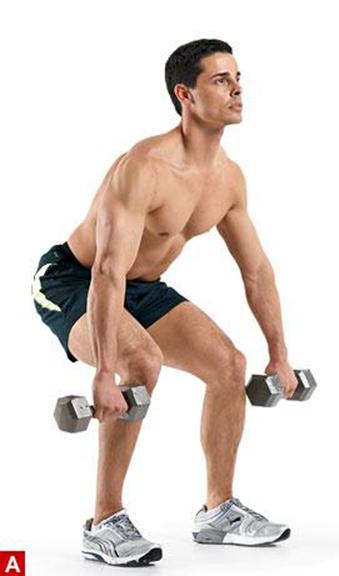
Keep your lower back naturally arched.
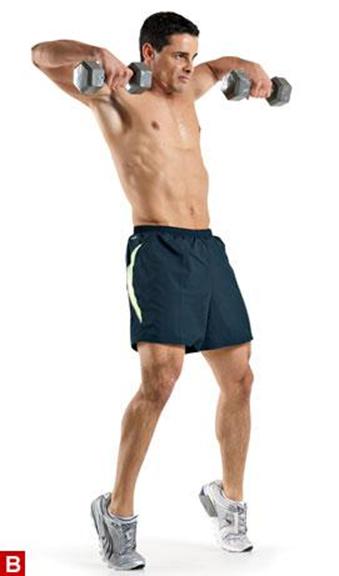
Explosively pull the dumbbells upward.
2. Offset Dumbbell Reverse Lunge
Stand tall holding a dumbbell in your left hand next to your shoulder, with your arm bent. With your right foot, step backward and lower your body until your back knee almost touches the floor. Push yourself back to the starting position and repeat. On then next round, hold the dumbbell on your other side, and step back with the opposite leg.

Let your right hand hang at your side or place it on your hip.

Keep your torso upright.
3. Single-Arm Dumbbell Swing
Hold a dumbbell at arm’s length in front of your waist, with your knees slightly bent. Without rounding your lower back, bend at your hips and swing the dumbbell between your legs. Keeping your arm straight, thrust your hips forward and swing the dumbbell to shoulder level as you rise to a standing position. Then simply swing the weight back and forth.

Push your hips back and keep your lower back naturally arched.
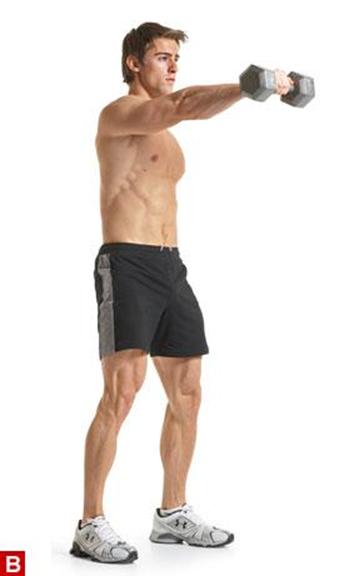
Your arm should swing up from your momentum.
4. Thrusters
Stand holding a pair of dumbbells next to your shoulders. Push your hips back, then bend your knees and lower your body until your thighs are at least parallel to the floor. As you push your body back up from the squat, press the dumbbells above your shoulders until your arms are straight. Then lower the dumbbells back down to your shoulders, and repeat.

Your feet should be set shoulder-width apart (or a little wider).
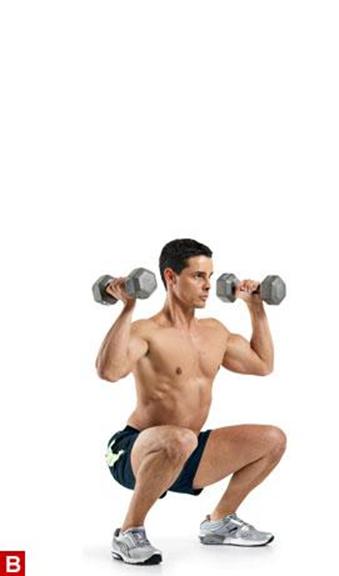
Squat as deep as you can.

Push the weights directly above your shoulders.
5. Single-Leg, Single-Arm Underhand-Grip Dumbbell Row
Grab a dumbbell in your right hand, then bend at your hips and place your left hand on a bench in front of you. Raise your right leg so that it’s in line with your upper body. Now let the dumbbell hang straight down from your shoulder, your palm facing forward (an underhand grip). That’s the starting position. (If you prefer, you can use an overhand grip (so your palms would be facing behind you), instead of an underhand grip.Pull the dumbbell to the side of your torso, by raising your upper arm, and bending your elbow. Pause, then slowly lower the dumbbell back to the starting position. That’s one rep. On your next round, switch arms and legs.
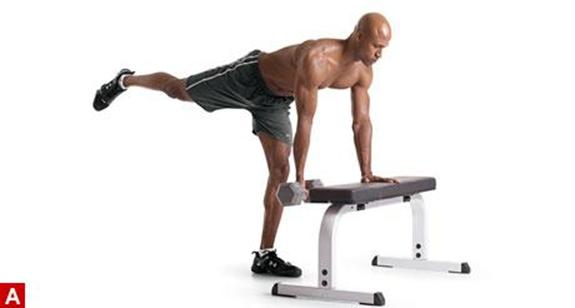
Your lower back should be naturally arched and your torso parallel to the floor.

As you pull the dumbbell upward, try to “squeeze” your shoulder blade toward your spine.
STEP 2
Each exercise is a “station.” At each station, do as many reps as you can in 40 seconds, rest for 20 seconds, and move to the next station. Go until you’ve done two circuits, then rest 2 minutes, and do another 2 circuits. You’re done!
1. Dumbbell Chop
Grab a dumbbell and hold it with both hands just above your right shoulder. Swing the dumbbell down and to the outside of your left knee by rotating and bending your upper body in the same direction. Reverse the movement to return to the starting position. On your next round, switch sides, this time holding the dumbbell over your left shoulder and chopping to down and to your right.
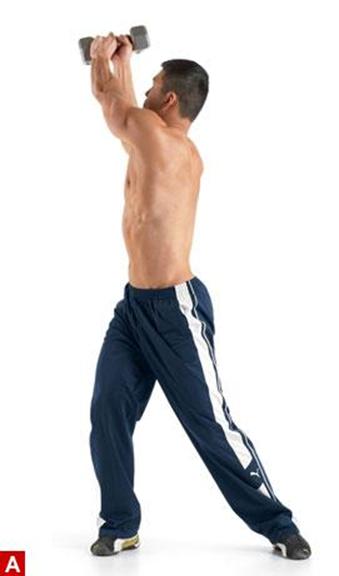
Place your feet shoulder-width part, with your knees slightly bent.
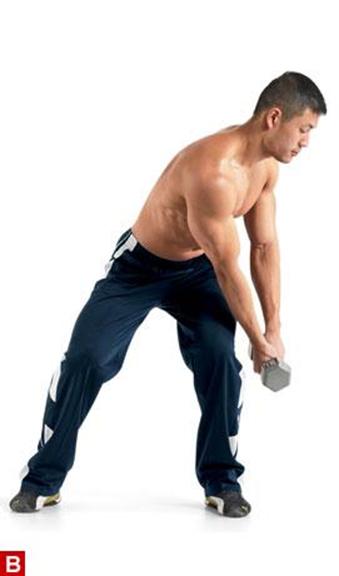
Don’t round your lower back.
2. Plank Walkup To Pushup
Start to get into a pushup position, but bend your elbows and rest your weight on your forearms instead of your hands. Your body should form a straight line from your shoulders to your ankles. Now brace your core by by contracting your abs as if you’re about to be punched in the gut. Without allowing your body posture to change (don’t let your hips sag!), place your left hand on the floor, then your right hand. Then push your body into the “up” position of a pushup. Now do a pushup. Then lower yourself back to your elbows into the plank position, by placing each elbow on the floor again. Repeat as many times as you can.
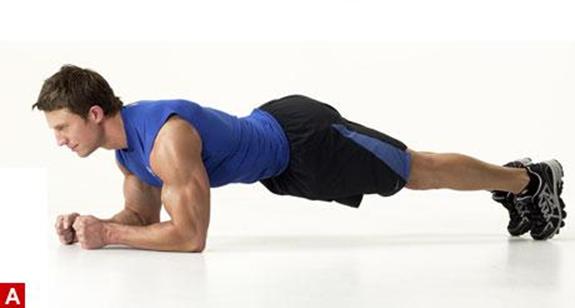
Brace your core and hold it tight for the entire movement.

One at a time, place your hands on the floor. Then push up until your arms are straight.
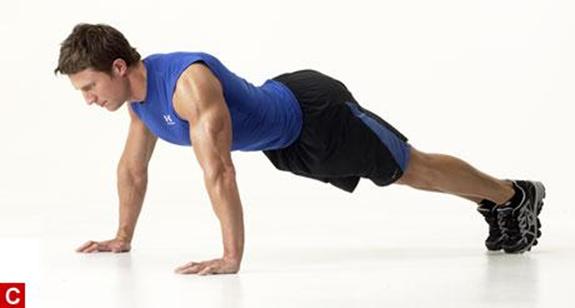
Once in this position, lower yourself down into a pushup, then push back up. Now return to position A, one elbow at a time.
Rotational Dumbbell Straight-Leg Deadlift
Grab a dumbbell in your right hand and hold it next to your side. Stand on your left foot with your knee slightly bent. Lift your right foot off the floor and bend that knee slightly. Without changing the bend in your left knee, bend at your hips (don’t round your lower back), and lower your torso as you rotate it to the left and try touch the dumbbell in front of your left foot. Reverse the move to the starting position and repeat. On your next round, switch arms and legs.

Hold the dumbbell so that hangs vertically.
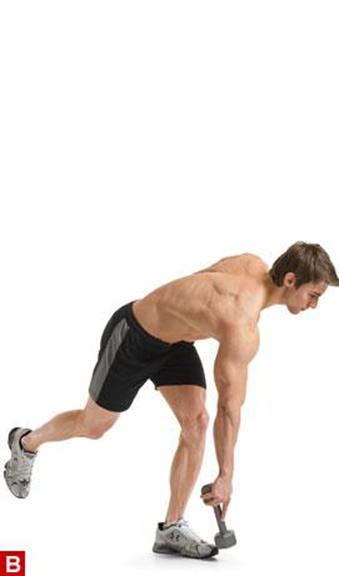
Keep your lower back naturally arched.
4. Squat Thrusts
Stand with your arms at your sides. Push your hips back, bend your knees, and lower your body as deep as you can into a squat. With your hands on the floor, kick your legs backward so that you’re in a pushup position. Then quickly bring your legs back to a squat and stand up.

Your feet should be set about shoulder-width apart.

As you squat down, place your hands on the floor in front of you, shifting your weight onto them.

From the pushup position, return to the squat (position B, above). Then stand up quickly.
5. Jump Squat
Stand with feet about shoulder-width apart. Place your fingers on the back of your head and pull your elbows back so they’re in line with your body. Push your hips back, bend your knees, and squat down. Then jump as high as you can. When you land, squat and jump again. If that’s too easy, hold a pair of dumbbells at your sides as you perform the exercise.

Lower your body until the tops of your thighs are at least parallel to the floor.

Explode up from the floor quick